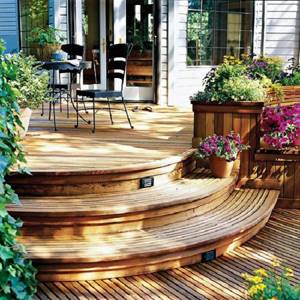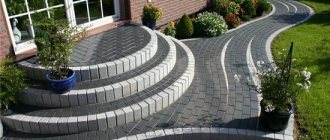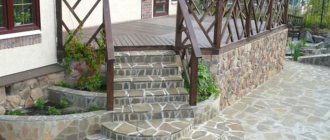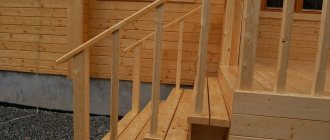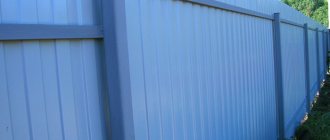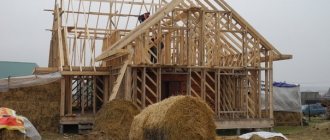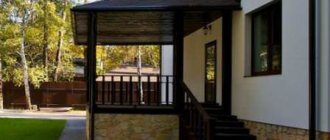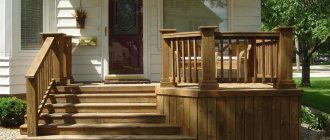A ramp is a surface located at a certain angle relative to ground level. The main purpose is to facilitate the movement of wheelchair users. Always consists of three parts. With the help of this device, people with disabilities can overcome stairs or thresholds. At the beginning and end of the ramp, the platforms are placed horizontally, and between them there is an inclined surface. It is clear that placing a ramp on the porch is simply necessary.
Features of ramp installation
In order to make it convenient for disabled people to climb the ramp independently, it is necessary to pay attention to the following details regarding its arrangement:
- The main parameter that you need to pay special attention to is the slope of the ramp. To determine this value, it is necessary to calculate the ratio of the height of the ramp to its length. According to the standard, this ratio should be about 8%. In rare cases, a slope of up to 10% is allowed, but no more.
- The next value, which plays an important role, is the length of the ramp surface. Considering that disabled people must move along it, and manage it independently, the length of the inclined surface should be correctly determined. Here you should refer to certain norms according to the standard. The fact is that the height of the upper part of the ramp above ground level should not exceed 0.8 m. Taking this value and the angle of inclination into account, it is easy to calculate the length.
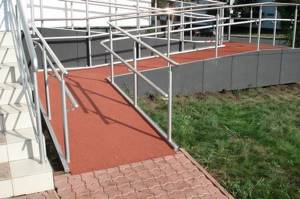
- The width is usually standard sizes. It must match the width of the wheelchair wheel mount. If a metal or wooden ramp is installed, then guides for the wheels are installed here. And the width of the guides should also be sufficient to ensure that the wheels of the stroller fit and do not get stuck.

- Very often, in the manufacture of ramps, mistakes are made when arranging the areas in front of and after the ramp. Most often, builders do not pay attention to the size of these parts. But for lifting disabled people without assistance, these parameters are also important. The width of the platforms must be equal to the width of the ramp, and the length must be at least 1.3 m.
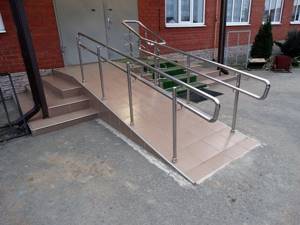
- The next point is the arrangement of the sides. Their presence will prevent accidental slipping of the wheels from the inclined plane.
The procedure for making a porch yourself
Stage 1. Foundation
The construction of a brick porch should begin with the construction of the base. Moreover, if the installation of this auxiliary element of a residential building begins after the completion of the last one, it is important to firmly connect both foundations to each other.
The foundations must lie at the same depth and represent, as it were, one solid structure. In this case, when the soil shrinks, the process will occur in the same way for both the house and the porch.
If this rule is not followed, subsidence will occur separately, which is fraught with the appearance of cracks in the base of the structure and the complete destruction of the structure created with your own hands.
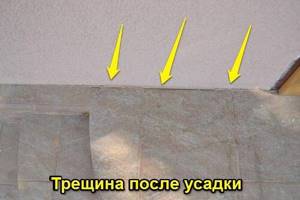
The photo shows the consequences of improperly made foundation
In rare cases, it is not possible to install a foundation on the same level as the house. Then you need to act according to the following scheme:
- It is advisable to place the lower edge of the porch support in the ground below its freezing level;
- if the groundwater level is high, a trench can be dug to a depth of about 80 cm, but there is no need to firmly connect the foundations of the house and porch; it is enough to drive in a few pieces of reinforcement and fill them with concrete.
Now let's look in more detail at how to cast a reliable foundation to attach a porch to a brick house:
- A pit is dug to the length and width you need . After completing the excavation work, the bottom of the pit is leveled and a crushed stone cushion 10 cm thick is poured, which is carefully compacted.
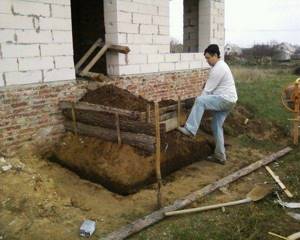
Preparing a pit for a porch
- Reinforcing mesh is installed . It needs to be made from reinforcing rods 10-12 mm thick, which should be twisted with wire into a mesh with a cell width of 20-25 cm.
- The concrete solution is prepared and the foundation slab is poured . The ratio of cement, sand and crushed stone is standard (1-2-5). Take care of the correct strength gain. During hardening, the surface of the concrete monolith must be moistened from time to time with water or covered with plastic film to prevent the rapid evaporation of moisture.
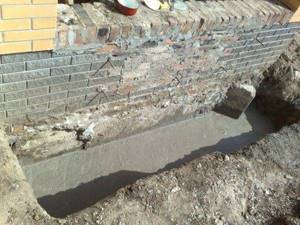
The foundation of the future porch poured with concrete
- After drying, several rows of brickwork are made on top . You can use rubble brick, the price of which is low. The upper part must be carefully leveled using cement mortar.
Stage 2. Waterproofing
We continue to build a brick porch with our own hands. To prevent the foundation you have made from being destroyed by precipitation and groundwater, it must be thoroughly waterproofed.
Note! Many novice builders completely in vain do not pay due attention to this stage. However, waterproofing should never be neglected. If the porch of a brick house is not protected from water, moisture penetrating into the pores of building materials will quickly destroy the structure.

The work is carried out in two stages:
- Protection of horizontal surfaces. For this, the selected material (most often ordinary roofing felt is used, but you can choose something more effective and expensive) is laid on the constructed foundation. It is necessary to arrange two layers located perpendicular to each other.
- Treatment of vertical surfaces. If you are building a porch for a private house made of brick, the basement of the home is also subject to additional waterproofing. It is necessary to lay sheets of roofing material or waterproofing in those places where the structural elements of the extension will be adjacent to the wall.
Do the work carefully so that after construction is completed, the layer of roofing material does not protrude beyond the masonry, as this will spoil the visual perception of the facade of the house.
Stage 3. Selection of materials
Before you build steps for the porch, you need to decide on the type of artificial stone used.
Some inexperienced craftsmen think that low-quality building materials can be used to build auxiliary buildings, including an extension to the front door. For example, remains from the construction of a house, waste from dismantling old buildings, defective elements, and so on.
It is not worth building a porch from such bricks, despite its cheapness
This is strictly not recommended due to the low quality of the building materials mentioned above. The porch, despite its apparent insignificance, constantly experiences significant external loads, so its strength should be given increased attention.
The use of used or broken bricks can lead to the fact that the structure you erected will quickly collapse and you will have to start work from scratch.
The best choice for the job would be decorative facing brick. But you can also use high-quality rubble, which at the last stage of construction is covered with ceramic tiles.

A brick porch made of such artificial stone will become your pride
Stage 4. Making steps
Having finished pouring the foundation and waterproofing it, having purchased the necessary materials for further work, you can begin to make steps for the porch with your own hands from brick.
But before that, it is advisable to decide on their sizes:
- According to current building regulations, the width of the step should be 30 cm. Then the resulting staircase will be convenient for the average person to use. However, this may vary depending on the design of your porch.
- The standard height of each step is 15 cm. This is a masonry two bricks high.
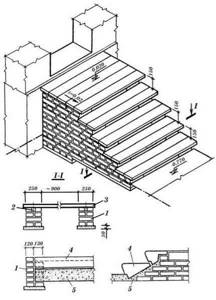
Example of calculating the size of steps
- The number of steps depends on the height of the base of the house. Be that as it may, you need to calculate this parameter so that a person stands on the upper platform in front of the front door with the same foot with which he began climbing the stairs.
- Make sure you have a fairly spacious area in front of the entrance. Its area should be such that a person can open the door without going down the stairs. At a minimum, it is inconvenient, and at a maximum, dangerous.
It remains to tell you how to lay out the steps:
- The first row is laid directly on the waterproofing layer. The outer edge, as already mentioned, can be made from expensive facing bricks, and the inner part can be filled with rubble.
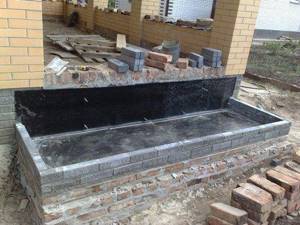
The first row is laid directly on the waterproofing layer
- When starting work on the next element, make sure that the previous one does not collapse. There is no need to be in too much of a hurry to finish the construction. Better monitor the quality of work: check the horizontal and vertical lines, carefully seal the seams in the brick, and so on.
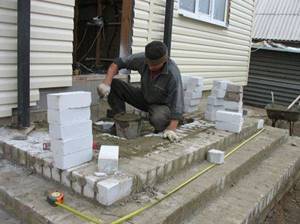
Carry out the work on making steps carefully and efficiently
- Some builders fill the surfaces of the steps with concrete, believing that this will protect the structure from moisture penetration. There is no need to do this. It is enough to carry out a thorough hydrophobic treatment at the last stage of construction or use a waterproof material for cladding.
Stage 5. Canopy
A small roof over the entrance to the house and the stairs is not only an attractive architectural move, but also protects the home and the porch itself from the adverse effects of the natural environment.
The following materials can be used to make a roof:
- Profiled metal sheets. Not the best material, although quite inexpensive. The fact is that during rain, thin steel will make a lot of noise, which will not bring pleasure to the inhabitants of the cottage.
- Polycarbonate. This option is more popular. The roof made of two-layer plastic has an attractive appearance, low weight and ease of installation. In this regard, you will not need to construct powerful supports.
Brick porch with polycarbonate canopy
Advice! The porch roof can be decorated with the same material that was used in the construction of the house. So the extension to the entrance and the dwelling itself will form a single architectural ensemble. The design of your plot of land will benefit even more if you make a gazebo and carport in the same style.
Stage 6. Decoration
The final stage of construction is giving the self-built porch an attractive appearance.
In principle, if you used high-quality and expensive building materials - for example, decorative bricks - the structure itself will look great.
Otherwise, you will have to make additional efforts:
- In most cases, extensions to the front door are decorated with tiles. When covering steps, make sure that you use material with a non-slip surface, otherwise using the stairs will be dangerous.
- You can use other design options. Be sure to take into account the design of the facade of the house, otherwise the porch you built will look alien.
- Don’t be afraid to use additional accessories: wrought-iron railings, pots with fresh flowers, sculptures, figured balusters, and so on.
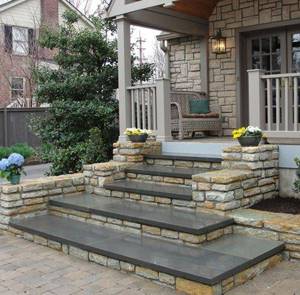
Brick porch after completion of decorative finishing
Requirements for handrails
Often ramps, especially those that are low, are equipped without handrails. But there are also certain requirements for this element:
- Handrails must be used if the height of the ramp is more than 15 cm or the length of the inclined plane is more than 180 cm.
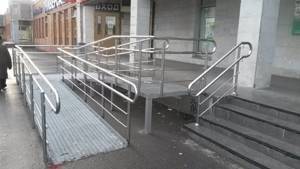
- Handrails must be attached on both sides of the rise and be at least 30 cm longer.
- They should be round in shape and their diameter should be 30–50 mm. The integrity of the handrails must not be compromised.
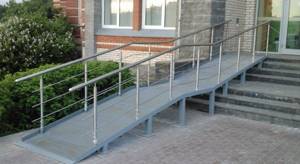
- The handrails should be double, and if a disabled child is expected to move, then triple. The height of each location starting from the top is: 80 cm, 60 cm, 50 cm.
Important! If deviations from the norms were made in the arrangement of the ramp for disabled people, this can lead to traumatic situations.
Which option to prefer?
Real methods of making a semicircular porch come down to the following:
- Cast a semicircular porch frame from concrete with further finishing and cladding;
- Constructed from bricks and ceramic tiles;
- Build a porch from rubble stone with finishing of the entrance platform and steps.
The simplest of the above can be considered the second option, the most complex is the last one. To lay rubble stone, you will need remarkable strength and patience; the result may not always exceed expectations, as in the video
If it doesn’t work out, you can use the scheme for using the boot suggested in the video
In fact, semicircular porch structures, built by a professional hand, can be very beautiful, even in the most ordinary houses, as in the photo.
